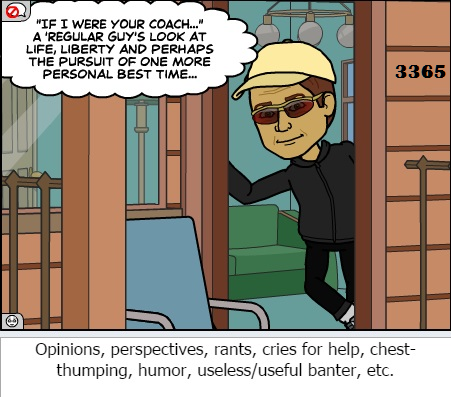There are certain attributes that an athlete can work to improve with (and in many cases without) the aid of a coach. The runner's gait, stride length, and number of steps taken per minute are a good example. The erectness of the runner's posture, arm swing, bend of the elbows and tightness while on the run are other good examples; once taught to a runner it's amazing just how simple it is for them to check on their own. One of my former athletes used to do her training runs on a seven-mile loop near my home; she instinctively would do a status check when she saw a vehicle which looked like mine.
I guess she thought I was going to roll down the window and tell her what fixes were necessary.
Even with a treadmill (and especially in a gym - all those mirrors!) the little form checks can be done. Nothing says you can't take a little phone camera/video time in the midst of the workout...or find someone willing to do a minute or two for you. Some coaches will gladly charge you a couple of bucks to do a video analysis, but most folks know that proverbial "sweet spot" when all of the mechanics feel right and the efficiency is maxed. There's no single perfect form, but there is the form which is best for the individual at that point in time. It's not always fixed; it can change as we become more (or less) fit, and it definitely changes as we age.
Runners (and coaches) can suffer from "analysis paralysis" because of the qualities which can be measured. Some of the measures are firmly understood, such as the amount of time it takes to cover a measured/defined distance; less time ideally means the runner is improving. A less firm measure would be a runner's physiological response to stress; a faster pace at a particular heart rate or a lower heart rate at the same pace over time can suggest the runner is getting stronger...adapting better to the stress of running. Other measurements, such as VO2max...the amount of oxygen an athlete processes at speed, are in theory predictors of performance but don't have a direct impact on running performance. A person can have a great predictor measurement and not live up to the (expectation of that) standard.
I often think about the 2009 commercial about underdogs. There's a line about the theory of competition, saying that the strongest performer (the person with the potential-to-performance mismatch) can still get their back-side handed to them on the day.
Usually by the person who's working harder than their other "numbers" say.
Desire and drive cannot be coached. It's something that comes from the athlete, something that makes rewards and incentives a bit of a crap shoot. Some people like technical shirts, others like bottle openers, others want beer mugs, and so on. I used to think desire couldn't be measured; until the age of social media, now I can figure out an athlete's degree of hunger in an indirect way. What are the chances of this person really showing up for a training session? Is there a need to think of "training and?"
What's "training and?" That's when the social function is appended to the training evolution, like a cooler of adult beverages or breakfast/brunch after the sweat-fest. Problems start when the masses focus on the "and;" that's when the coach realizes they've devolved into a social coordinator.
I like to tell folks what I'm up to at the gym or out on the roads; I "talk" a good workout, it sounds (much) more difficult on screen/paper than it really is. I like (running-related) company on Saturday morning, on Sunday morning, on Monday night (my easier stuff) about as much as I like to train alone (my harder stuff). But I know peer pressure works both ways; it's hard to not be in the "Saturday-evening-at-the-watering-hole-selfie" because the end result will be a Sunday morning long run with a hangover. "My head aches only a little less than my legs at this moment..."
There's nothing wrong with wanting to be a social runner. The problem comes when I have to deal first with ambivalence, and then with frustration. I can help with the training; the problems come when the desire comes for "training and."


No comments:
Post a Comment